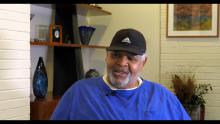
Nathaniel Garland
Albemarle High SchoolPhyllis Leffler: You know as you’re starting to go to schools like Rose Hill or Stone-Robinson, was there any talk in your home about this desegregation process or integration process?
Nathaniel Garland: Yes, it was in the home, but I also had these experiences when I would get on the bus with my mother and go to Charlottesville. When we got on the bus, and the bus was full, “Honey, step back.” There was a line on the bus that I couldn’t stand in front of. When I went down to the bus terminal, which was downtown in Charlottesville then, there was a white water fountain and there was a colored water fountain, and I made sure that I went to that one. And so these things stood out. The Branchville Pool Hall was there on Main Street and of course, I was too young looking in, and they go, “Nah, you can’t go in there.” So we went to Vinegar Hill. That’s where Radio Barbershop was, and we went to get our hair cut and so forth, and so that’s where the stores were. And Bull’s shops and all that went down and of course, Vinegar Hill was razed to make way for urban renewal development. All of that stuff went away. And so yeah, I was familiar with it, and I knew that there was certain that I didn’t do and I couldn’t do, and it would cause problems for my mother and possibly cause problems for me. When you went to the stores in Crozet or whatever, I’d be in my mother’s arms. “Honey, no, we don’t go in there. We only go here.” And you sort of understand it, but you sort of don’t understand it. It’s a rule. Mama says, so you follow that. But as I got older, I would hear about, “Yeah, you know we don’t,” and I’ve asked a couple times. “Why don’t we go to school just like--” They said, “No.” And I did know this much: I knew what separate, but equal meant. They said, “Schools are separate, but they’re equal.” Well, when I got to Stone-Robinson, I found out that wasn’t true.